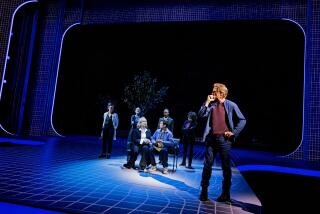A dizzying global vision
NEW YORK â On a bitterly cold night in January, in front of a packed house at the Lower Manhattan Cultural Center, Marianne Weems and Keith Khan are experiencing technical difficulties. The two are trying to show excerpts of their touring multimedia theater collage, âAlladeen,â but the DVD theyâve brought along for the presentation refuses to fast forward.
Weems, a New York-based theater director known for the sophisticated way she mixes new media with live performance, calls out repeatedly for help. Though sheâs clearly flustered, the irony isnât lost on her. The story of a path-breaking auteur, renowned for her computer and video wizardry, being publicly defied by a recalcitrant laptop would make an ideal setup for her next piece.
âIâm not interested in the stage apart from the screen,â says Weems, a formidably articulate practitioner of what she refers to as âcross-mediaâ theater. âWe all spend a good portion of our day in front of one, whether itâs a computer, TV or movie, and this affects the way we see the world.â
âAlladeen,â Weemsâ latest directorial undertaking, dramatizes the way developments in global communications have surreally altered our sense of self. Moving from New York to Bangalore, India, to London with the ease of a computer click, the multimedia dance of ideas revolves around a group of call-center workers in India who pose as Americans while fielding customer-service requests with satellite phones and high-speed Internet tools.
Since co-founding the Builders Association in 1993 after serving as dramaturge for the Wooster Group, Weems has sought out stories that narrow the gap between virtual and live performance. âMy interest is in what happens to human bodies when caught in a web of technology,â she says. âI like to immerse performers in a mediated environment and then see how they can articulate their presence from within that space.â
âJet Lag,â for instance, her 2000 Obie-winning piece, was a diptych involving characters journeying great distances on video while never really making any progress geographically. âXtravaganza,â the companyâs 2001 production, surveyed the history of multimedia work in ways that catapulted the art formâs first practitioners far into the computerized future.
âAlladeen,â at REDCAT March 3-7, is the result of collaboration between Weemsâ company and Khanâs London-based motiroti, which has specialized in cross-cultural spectacles. Motiroti is not only the groupâs name but also the title of its inaugural production, dubbed as âthe first Bollywood musical.â
Khan describes his metier as âcelebrating and burlesquingâ U.K. diversity, which he apparently demonstrated in epic fashion as artistic director of Celebration Common Wealth for the Queenâs Jubilee Parade and director of design for the opening and closing ceremonies of the Commonwealth Games 2002.
âKeith is the Busby Berkeley of London,â Weems says admiringly of her colleagueâs stylishly populist sensibility. âThe Bollywood piece was both a send-up and an entertaining appreciation of the cliches and in that respect far more sophisticated than most identity politics art in the States.â
A sleekly groomed visual artist, Khan is âvery curious about why people donât go to the theater as opposed to why they do.â Much of the work heâs been developing in London has been about âopening the door of the theater to prevent it from being a hermetically sealed environment.â
Having started out as a designer of elaborate costumes at the Notting Hill Carnival, he went on to make large-scale projects on multicultural identity -- a subject he finds especially rich as a Trinidadian-born Englishman of Indian descent with a silky BBC accent.
Weems and Khan had been toying with the idea of collaboration on an Aladdin project, but they were searching for a contemporary hook. The inspiration came to Weems through a story in the New York Times titled âIâm in Bangalore (but I Canât Say So),â which focused on Indian telephone agents trained to âpassâ as Americans, so that no one dialing a 1-800 number need ever suspect that the call is super long-distance.
A synthesis of both the Buildersâ and motirotiâs interests, âAlladeenâ (the title is a phonetic version of the Arabic name) explores one of the Faustian bargains of global technology: the way overseas customer-service workers are invited to perform U.S. jobs, but only at the cost of their own national distinctiveness.
âThe more we looked at different film versions of the Aladdin story, the more we began focusing on the themes of instantaneous wish fulfillment, the fantasy of endless wealth, and the desire for personal transformation,â Weems says. âThe call center material provided a modern frame for us to explore these tropes.â
The analogy, while not airtight, has sneaky resonance. After all, employees in these âglobal centersâ are able to whisk themselves across continents via the Internet at speeds that defy even the fleetest of magic carpets. Professional selves are permitted to transmogrify at will. And for all the new jobsâ cultural fallout, they provide needed economic uplift, even if the financial rewards fall short of a cave full of gold.
Weems, Khan and Ali Zaidi (motirotiâs video designer) went to Bangalore to videotape interviews with these workers, whose employers required a program of Americanization that includes seminars on âneutering the mother tongueâ as well as an introduction to âFriendsâ and âAlly McBeal.â Workers, in fact, are encouraged to assume not only aliases but also personality attributes of the characters from these popular series.
No sides are taken
The video streamed into âAlladeenâ comes from the Bangalore interviews, which can be viewed on the productionâs website (www.alladeen.com) -- one of the ways, along with an âAlladeenâ music video released in Asia, that the artists hope to broaden their theatrical audience.
Given the recent attention these call centers have received, this shouldnât be hard to do. As anyone keeping tabs on the presidential campaign knows, outsourcing has become a hot political football. The issue may be even hotter on the other side of the world, where the prosperity brought by globalization often demands a level of assimilation to an outside corporate mentality that for some is redolent of old-fashioned colonialism.
But the biggest controversy dogging âAlladeenâ may have to do with the neutral way it treats its loaded subject matter. The production refuses to take sides in the debate.
âSince the people are allowed to speak for themselves, what it adds up to is a very varied view of whatâs happening to their identities,â Khan says. âItâs not about hitting you over the head with what to think. Instead, itâs about presenting the information as it was presented to us in India, and allowing members of the audience to make up their own minds.â
Jeff Webster, one of the five live performers portraying call-center employees on screen, says it was important for him not to see these people as victims. âMany in the documentary footage speak about being empowered by their new positions. Itâs a double-edged sword, and both edges need to be visible.â
Some, however, have felt that the material requires sharper political scrutiny. (The Village Voice, for example, questioned whether the production relies âtoo much on the technology of global capitalism to critique its effects in fresh terms.â) Others have complained that the narrative strands are too fragmentary. (âWhere it might build up the characters and narratives of the Bangalore workers, Alladeen wastes its energies on linking their stories with that of Aladdin, the poor boy who wished himself new,â said the Manchester Guardian.)
But like nearly all of the Buildersâ work, âAlladeenâ has received lavish praise for its hallucinatory technical virtuosity, which strives ultimately to capture trends in contemporary consciousness.
And trendy the work has certainly been. Artistic luminaries such as director Julie Taymor, the Talking Headsâ David Byrne and composer-performance artist Laurie Anderson were all in attendance when âAlladeenâ had its New York premiere at the Brooklyn Academy of Music in December. (The world tour was launched in spring 2003 at Columbus, Ohioâs Wexner Center.)
Susan Sontag, who serves on the Buildersâ board of directors, is perhaps the most prominent supporter of the group. âI consider them to be, after the Wooster Group, the most exciting theater company in the States,â she says. âThe genealogy, of course, is the Wooster Group. Marianne was trained there, but sheâs gone down a different road. Her theater explores multimedia techniques not only formally but also in terms of their political and human meanings. Itâs a perfect joining of dazzling technical means with a really substantive subject that is both theatrically and emotionally rich.â
The production, Sontag adds, signals a less rarefied direction in the theatrical avant garde. âThereâs not only form but content,â she says.
One thing is for sure: Anyone who experiences âAlladeenâ will have to think twice about where the voice on the other end of the customer-service line is coming from.
*
âAlladeenâ
Where: REDCAT at Walt Disney Concert Hall, 2nd and Hope streets, L.A.
When: Runs Wednesday to Sunday, 8:30 p.m.
Ends: Next Sunday
Price: $24-$38
Contact: (213) 237-2800
More to Read
The biggest entertainment stories
Get our big stories about Hollywood, film, television, music, arts, culture and more right in your inbox as soon as they publish.
You may occasionally receive promotional content from the Los Angeles Times.











